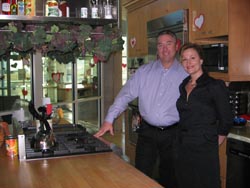- It's a phrase that has recently become a constant refrain in an industry that has always been focused on hardware: "Sell solutions, not product."
Listen Technologies has cooked up a new way to connect with customers at its headquarters in the Salt Lake City area. The manufacturer is already expanding the building it moved into last year. In the center of the main level there is a full kitchen, which Russ Gentner (left) and Cory Schaeffer have found is a great place to rally the troops.
Everybody is saying it. Manufacturers, trade associations, reps, consultants, and even a few contractors and integrators have found that there's something to gain from selling a system that answers a client's needs rather than just weaving model numbers and technological features into a complex sales pitch.
"Qualify your customer" is usually the answer to the question of "how" to sell a solution. Talk to a potential client about their needs and then recommend a system. We've heard it all before, but manufacturers are supporting this quest in new ways.
Moving beyond the one-source for a total solution approach offered by an increasing number of manufacturers, there is a new sales pitch in town, and it's focused on vertical markets and specific applications. For the manufacturers engaging in this new tactic, their battle cry should be, "Identify your market, then demonstrate how your product fits."
"Our dealer base is mostly reactive," observed Russell Gentner, president of Listen Technologies. "Business is so good that all that most integrators have to do is wait for someone to knock on the door and they get an order. We believe that there is a tremendous opportunity for manufacturers and dealers to go out after vertical markets and to really grow the pie."
Listen may have launched itself in 1998 as a manufacturer of assistive listening products, but vice president of sales and marketing Cory Schaeffer explained, "all along, our vision was other verticals, like tour groups, language interpretation, conferencing, and soundfield. But our challenge has been to get people to look at the sale that way."
Listen has designed its website so that dealers and end-users both have access to product information based on the type of project, rather than the other way around. In its continuing quest to align Listen products with more verticals, the company has created a one-sheet piece of literature for consultants, dealers, and reps that first lists application type and then suggests products for those vertical markets. With these marketing systems in place, hopefully "when people look for things specifically for houses of worship, they might see other products that work in that market," Gentner said. "Our philosophy is to market to end-users for vertical solutions and then drive those customers to our dealers, as opposed to selling direct. We think that dealers can add more value."
Another audio manufacturer that has specialized in a single product that can do just about anything is now testing out an applications-based selling approach. The new Integrator Series from Symetrix might be described as an inside-out version of the SymNet DSP solution. Starting with the 760, which will make an appearance at NSCA Expo this month, the Integrator Series will arrive with a built-in interface for specific niche markets, saving the integrator time on installation. "We thought it would be a good solution to be able to hand dealers something that would allow them to do the job quickly at a reasonable price," explained Michael Worona, director of business development for Symetrix.
The 760 was designed for applications in need of a background music distribution system, such as hotels, restaurants, and small casinos. It provides plenty of routing capacity and the basic functions for background music applications, plus a few bonus features from Symetrix' DSP toolkit. "We introduced noise generators on the inputs for situations that require some light sound masking, in an office for example," Worona said. "It's just a small feature that we can put in there, but it might fulfill a need. We put in a lot of routing and little extras like that so that we could cover the breadth of the market."
The idea with the Integrator Series is to provide flexible solutions for smaller I/O counts in a variety of vertical markets. Hence, Symetrix is doing a lot of work on the back end to make it easier to install a product and set up user interfaces on the front end.
"This type of fixed architecture is nothing new, but usually those products are trying to cover a lot of horizontal with a vertical piece," Worona noted. "We're trying to narrow the focus, make it a little more specific for particular applications. It's easy for us to spin out another version in a sense because of the way we've developed the product, we should be able to address a lot of applications."










